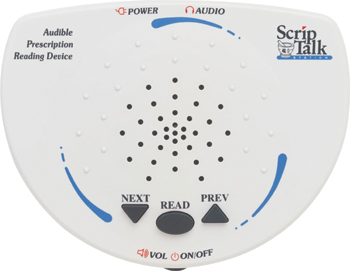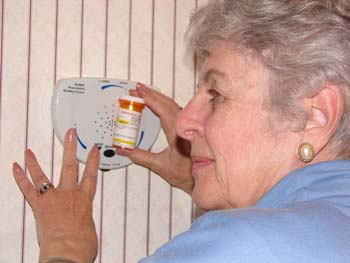AccessWorld has reported on the technical characteristics of En-Vision America's ScripTalk talking medication system in the past, and we found the technology works well. The use of assistive technology for identifying prescription medications is relatively new, and only a relatively small number of people have access to it; therefore, we thought it would be useful to talk with some people using ScripTalk.
Caption: The ScripTalk Device
This article summarizes conversations I conducted with ScripTalk customers, and I have used first names and geographic locations when appropriate. Names were provided upon request by En-Vision America. These interviews and the resulting information provided a sort of "snapshot" of individuals using a relatively new technology.
In Rochester, New York, Robert is struggling with a situation familiar to some who use pharmacies covered by a medical plan, and he contacted AccessWorld when he heard about our interest in the technology. Despite his efforts to find a local pharmacy using ScripTalk and several calls to large mail order pharmacies that contract with his insurer, Robert can not find a pharmacy that has, or will install, the ScripTalk technology.
Despite early interest and excellent response from the community, ScripTalk availability remains very limited. To date, no national drug store chain has made the system available in all its stores. Walgreens, however, has conducted pilot programs in northern Indiana and Arizona, where I understand ScripTalk was well received. Unfortunately, no information about increased availability from Walgreens has been announced.
Robert is a braille reader, and fortunately one mail order supplier he contacted has braille medication labeling available. Robert had not yet received his first prescriptions with the braille labels when he spoke with AccessWorld.
Robert's situation illustrates an important factor identified by several individuals we spoke to. A familiarity with several nonvisual techniques, including braille, allows for more options in selecting a strategy for medication identification.
Eric, who lives in Columbus, OH, started using his ScripTalk about 6 months ago. Like Robert, he is familiar with a range of blindness techniques. He told AccessWorld, "It's really all about the independence. I have two kids who could read to me, but having the information available to me directly makes all the difference." Eric reports he and his family do not use that many prescriptions and that because taking meds isn't always part of the routine ScripTalk is helpful, because it reminds him of information he may have forgotten over a long period of time.
Eric uses a small pharmacy in Columbus, and he approached them when he saw ScripTalk demonstrated at a national convention of the blind. They immediately saw the benefit and purchased the technology.
Because of his children, Eric asked his pharmacy to label all medications for his family with ScripTalk. "If the kids have to take a prescription, now I can make sure it is administered correctly," he said.
In Fort Smith, Arkansas, Peggy is an enthusiastic ScripTalk customer. "I love it," was her first comment shared with AccessWorld. She learned of the device from a friend in the local chapter of a major consumer organization. This reflects a pattern observed among customers. Word of mouth, especially through the efforts of consumer organizations, appears to be the most important method by which people learn about ScripTalk. This is an interesting trend, since many of the individuals we contacted would also have had an opportunity to learn about the system from medical professionals.
Caption: A woman using the ScripTalk device.
Peggy and a number of others in Fort Smith use Vaughns, a local pharmacy. Again the pattern for a local provider to receive the business from a number of ScripTalk customers in the community follows a trend.
Peggy said she doesn't use many prescriptions, "But, I have had several surgeries, and let me tell you, when you have meds that change or you aren't using them all the time, it is really great." Again the independence to accommodate variable requirements for taking unfamiliar medications is an important advantage of the technology.
Peggy uses low vision techniques and talking technology. She uses a CCTV, but that didn't work well, and before ScripTalk she had to find someone to read things to her.
In Boynton Beach, FL, Randi uses ScripTalk to identify five medications she takes on a regular basis. She shared a very serious situation with AccessWorld. Before using ScripTalk she mixed two similar sounding medications. "I had a difficult time sleeping after loosing my vision, and the doctors were changing my meds, trying to find the best combination," she said. She also told us before using ScripTalk, she was transferring her meds to special containers which allow you to record a message on each. "I travel extensively, and they didn't last and it was costing me a fortune to keep replacing these talking containers." Randi has no trouble traveling with her medications and ScripTalk unit.
On Long Island, NY, Dennis received his ScripTalk from the Veterans Administration. Any patient of the VA system can request a ScripTalk unit and to have medications labeled for use with it. Dennis also experiences significant hearing los, in addition to his visual impairment. He reports the ScripTalk Station, the current version of the technology, is easy to hear and works well either with the internal speaker or with an earphone when he desires privacy.
Most importance to Dennis is the ability to manage receiving his medications by mail. The VA supplies prescriptions by mail. "When things arrive, my wife usually has a look first, and if she doesn't recognize something, I immediately take it to the ScripTalk Station and find out what it is." Dennis has had good luck with the VA stating that with only a few exceptions it has always included the ScripTalk labels. "When it didn't, I just took the container of medication to the VA pharmacy, and they put the label on it for me," Dennis told AccessWorld.
The VA is an important provider of medical care and prescriptions for many blind and visually impaired veterans. As the first nation-wide distributer of the hardware and meds the experience of VA patients helped refine the technology for the current ScripTalk Station.
Several important themes emerged as we spoke with ScripTalk customers. The first noticeable trend is people are very enthusiastic about the technology. This holds true for experienced users of assistive technology as well as those for whom ScripTalk is their only specialized blindness technology.
Using ScripTalk, all the people we spoke with are able to identify their prescriptions with minimal difficulty. Early users of the first generation technology provided by the VA said the newer ScripTalk Station has resolved issues of difficult to understand speech they encountered in early versions.
The deployment of the technology appears to have been a very grassroots effort even for the VA, which has the technology available. Groups such as the Blinded Veterans of America play an important part in demonstrating ScripTalk and encouraging members to order and use the device.
The National Federation of the Blind has also been very active with building awareness of ScripTalk's availability.

